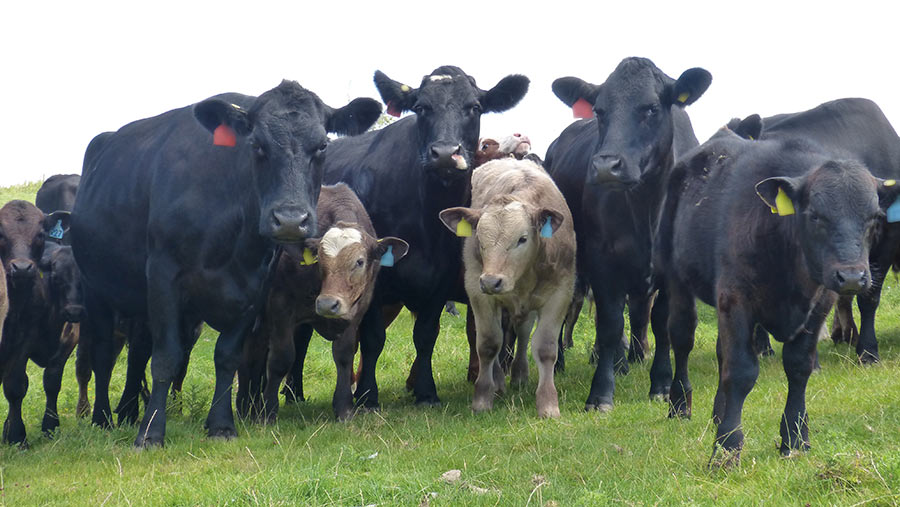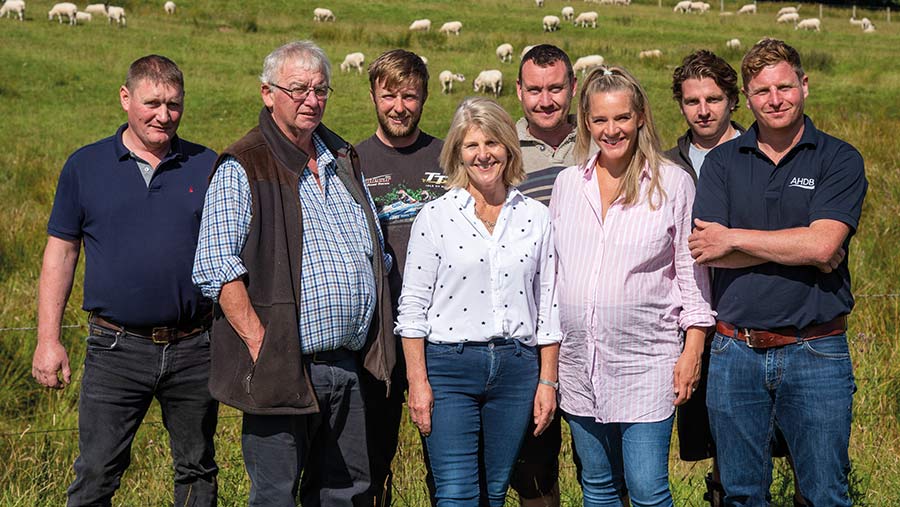Suckler unit trials outwintering lighter cows in bid to reduce costs
 Cows are mainly an Angus and Simmental cross © MAG/Michael Priestley
Cows are mainly an Angus and Simmental cross © MAG/Michael Priestley An upland suckler unit is cutting its housed period and silage requirement and aiming to reduce its costs, which were £525.85 a cow last year.
The Sordy family at Alnham Farm, near Alnwick, historically housed their Simmental cross Angus commercial suckler herd from November through to turnout after calving in April.
To do this, the farm made about 900t of pit silage and 500 round bales, plus 3,000 little hay bales for their ewes.
However, outwintering 80 suckler cows last year meant about 100 bales of silage were carried over and only 34ha (85 acres) of silage was cut this year, compared with 56ha (140 acres) last year.
See also: Video: Maternal traits ensure fertile and low-cost sucklers
This winter, the farm plans to keep 160 cows out until February, saving weeks on deep straw, and a tub-mixed straw, silage and pot ale syrup ration.
Farm facts
- 1,216ha (3,005 acres) mostly grassy hill up to 518m
- 225 suckler cows
- 2,500 ewes and 320 ewe lambs tupped
- 15ha (37 acres) of kale for wintering sheep
- 100ha (247 acres) of ryegrass and herbal leys
- 69ha (170 acres) of arable ground (wheat and barley)
- Angus, Simmental and Charolais sires
- Finished cattle go to Linden Foods
- AHDB Monitor Farm
Formerly tenants on Northumberland Estates, the Sordys are buying the farm while facing diminishing subsidy support.
Costs will be monitored in the hope of improving margins (see “Suckler cow performance at Alnham Farm, 2020-2021”) as part of being an AHDB Monitor Farm.
“Housing cattle through winter is great in many ways for peace of mind and routine,” says Harry Sordy, who farms with parents John and Jennifer, wife Helena and brother Peter.
“But diesel is more expensive, machinery costs are up and the price of wrapping a bale is up too.”

The Alnham Farm team has had to graze sheep differently this year to defer grass for outwintering suckler cows on © AHDB
The farm’s better in-bye ground has been subdivided to rotationally graze more productive parts of the farm. This allows sheep to be removed from the hill earlier to defer grass for wintering cattle.
Sheep are grazed and rotated to give pasture 21-day rest periods on four- and eight-paddock systems to allow regrowth recovery.
This has helped manage stocking rates and grass after the farm lost 364ha (900 acres) of outlying rented lowland ground.
Early days
Last winter, a bale-grazing trial on a hill worked well, with 80 cows fed with a bale unroller. This year the farm aims to outwinter two 80-cow mobs.
One mob will be on an 8ha (20-acre) hill of grass, deferred either since late May or early August; the other mob will be on 9ha (22 acres) of hill with two or three bales a day and a new strip of grass.
The deferred hill has been halved with a permanent fence. Cows will start at the edge of the farm and graze homewards on daily moves behind an electric wire with no back fencing.
After weaning, cows will be walked to the hills in November when in-bye conditions deteriorate. The aim is to only house the cows for 10 weeks, until turnout after calving, as opposed to about 16 weeks.
A contingency plan of an adjacent lower- lying area with a large wood will be used to shelter cows with straw and hay in harsh conditions.
Thinner cows, heifers and first-calvers will be housed for the winter.
Genetic changes
Herd manager Craig Hardy has been culling out large, inefficient cows to bring mature cow size down by 80-100kg to about 680kg to manage winter feed bills and help with outwintering.
“The biggest cows eat too much and cannot stand winter outside,” says Mr Hardy.
The farm has 57 heifers calving down this year, including 16 Luings, bought as an experiment with a smaller, hardy breed. These weigh about 500kg. The plan is to calve them outside, possibly on some stubbles before spring drilling.
Charolais terminal sires will be phased out as the farm looks to finish more cattle at home on herbal leys and forage-based diets.
Simmental genetics may continue in a criss-cross policy if the Simmentals can take outwintering.
Suckler cow performance at Alnham Farm, 2020-2021* |
|
|
Key performance indicator |
Suckler herd performance (a cow) |
|
Cost of production |
£525.85 (253p/kg) |
|
Home-grown forage variable costs |
£45.24 |
|
Home-grown forage overheads |
£143.59 |
|
Total feed and forage cost |
£232.62 |
|
*Based on selling calves at weaning Source: AHDB FarmBench |
|
Outwintering tips
Housing suckler cows during the winter was estimated to cost about £350 a cow before inflation pushed up input costs.
Outwintering, where cattle graze outside on forage, supplemented with conserved grass or straw, has been shown to reduce costs, including feed and labour, by nearly 70%, says AHDB senior knowledge exchange manager Sarah Pick.
Infrastructure
- Choosing the right field or hill is essential. Outwintering is best done on free-draining, sandy soil with a gentle slope – steep slopes increase the risk of run-off and soil loss
- Fields need to be well-fenced with a movable water supply to allow back fencing
- Cattle will need a dry lie such as a run back to grass, a headland area or a straw bed
- Grass buffer strips around fields help reduce water run-off
Winter forage
- Deferred grazing is more common in upland and hill regions of the country
- Brassica crops (kale, swedes, rape/kale hybrids) are often preferred in lowland areas, possibly in rotation with arable crops
- Brassicas are high in readily digestible carbohydrate content, but low in fibre. Due to their nutritional content, they require a transition period to allow the rumen microbes to adapt. Ideally, start by allowing the stock access to the crop one to two hours a day, before building up to unrestricted access after seven to 10 days
- Because of the low fibre content of brassicas, cows require supplementation with an additional fibre source such as straw, silage or hay. This must form at least 35% of their dry matter intake
- Brassicas are low in phosphorus, magnesium, copper, iodine and selenium, so supplementation may be required. They also carry an associated risk of hypocalcaemia, so it is recommended suckler cows are removed at least four to six weeks before calving
Body condition score
- Only cows in good body condition should be outwintered (3-3.5 score). Energy requirements for outwintering cows can be as much as 10-20% more depending on weather and body condition
- Cows in low body condition should be placed in a separate group or housed
- When considering outwintering sites, try to ensure there is adequate shelter which will help mitigate some of the effects of adverse weather
